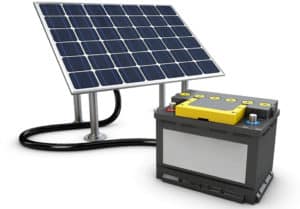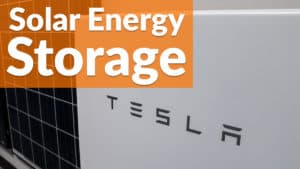If you are starting on the journey to go solar, a battery backup system is sure to come up in your search. Determining if this is something that would be right for your needs includes a number of factors. Do you plan to live completely off-grid? Are there any medical devices that need to be powered in the event of a blackout? These are just some of the questions you would need to consider. In addition, the size of your home and its energy needs should also be considered.
How Does A Solar Battery Backup System Work?
There are times when your solar panels are going to produce more energy than what your home needs. This is a good thing, and can save you money depending on which route you take. If you invest in a battery storage for solar, instead of your excess energy going back into the grid, it is stored in your battery. Like an “energy bank.” This stored energy can then be used in if the power grid goes down.
Solar batteries can either be AC-coupled or DC-coupled. With AC coupling, the power from your solar panels is converted through a inverter from DC to AC, and is then converted by a battery inverter and stored in the solar battery as DC power.Then when the power is needed, the battery inverter converts the power from DC back into AC power for it to be used.

With a DC-coupled solar battery, power from the solar panels is directed into the battery through a solar battery charger that regulates how the batteries are charged. Here it isn’t necessary to convert the power because solar panels produce DC power and batteries store DC power.
Types of Solar Battery Backups
Batteries used to be a lead-acid battery bank hooked up to an off-grid solar battery charger and battery inverter. The batteries, battery charger, and battery inverter were all separate. They were also large and heavy. And more often than not they would only last long periods when the depth of the discharge was limited to 40-50% of the batteries capacity.
However, as with most things, solar battery backups have gotten better over time. The newer technology of Lithium-ion (Li-ion) has made its way to solar batteries. These are the same batteries in cell phones and computers and can now be discharged to almost 100% of their total storage capacity. Not to mention, they have greater energy density per square foot and per pound of weight.
When Would A Battery Backup Storage Be Necessary?
There is a lot of information out there suggesting that a battery backup system is the best route to take for any homeowner looking to go solar. However, when the cost is factored in, this may not be the best financial decision.
For homeowners who chose to stay on-grid, the option to participate in net metering is a major financial benefit. Net metering allows homeowners to bank excess energy with their utility provider which can be used later, should their energy consumption be more than the energy their solar panels have produced. This option also allows homeowners to earn credits with utility companies, which are then paid back to at the end of their 12 month usage cycle.
For many, net metering alone negates the option of a solar battery backup system. This is because when you have battery backup, it can mean you’re off-grid or disconnected from the utility company. When this happens, you cannot participate in NEM (Net Energy Metering), which means you don’t qualify for its incentives.
Being off-grid is one of the few reasons homeowners would choose to invest in a battery backup system. Solar does not work at night, nor do they work if the grid goes down for any reason. In these instances, battery backup has its advantages. Being able to store your excess energy in your battery to use at a later time, night or otherwise are the main reason for battery storage. However, Most batteries cannot take your home completely off the grid to the point where you sever your connection with your utility provider. This is important to know since battery backups simply don’t have enough storage to power a home for days on end in the event of extended cloudiness, rain, or snowy weather.

If you have chosen to stay on grid, you can still have battery storage. Battery storage is especially handy should you experience a black out. It’s important to note, during those times, batteries are not made to power an entire household. Only the important appliances, or areas of the home will have power, unless you invest in more than one battery storage.
Can You Add Battery Storage After The Fact?
Adding a backup battery after a solar installation can be done. The level of difficulty will just depend on whether your solar panel system was designed with the intention of adding energy storage later on or not.
If you have a “storage ready” solar system, you will have an inverter that can easily handle a battery being added into your solar panel system. In this situation, a battery is relatively simple to install, and the installation process won’t require much additional equipment.
If your solar panel system was not originally designed with the ability to add storage later, the installation will be slightly more complicated. However, most solar installers can handle either scenario with little effort from you. It is worth noting that every energy storage project will be different. If you are interested in adding a backup battery to your existing solar panel system, make sure to share as many details about your system as possible with your installer to determine what kind of system is the best fit for your home.
Are There Any Rebates For Battery Backups?
You’ll be happy to know that there are a number of rebates available across the United States for renewable energy. Solar Battery Backups fall in this category. These rebates include federal tax credits (also known as the ITC), as well as some state and utility rebates.
While each has their own requirements, here is a brief description of them:

Federal Tax Credit (ITC) For Solar Batteries
The federal solar tax credit is the most significant solar tax incentive in the US. Currently worth 26% in 2020, for batteries to be eligible the solar battery must be charged 75% or more by the solar panels. When calculating your battery tax credit, you multiply the percentage of battery charge supplied by solar, e.g. 80% by the 26% from the tax credit (0.8 x 0.26). This will allow the cost of your batteries to be claimed as a deduction to your federal tax liability.
California: Self-Generation Incentive Program (SGIP)
The California Public Utilities Commission, operates this program. It provides incentives on distributed energy resources to businesses and homeowners. It also covers fuel cells, wind turbines, and waste-to-heat.
Massachusetts: Solar Massachusetts Renewable Target Program
The SMART program in Massachusetts provides incentives for a variety of technologies. Technologies that can qualify for the program include solar photovoltaic’s, solar thermal, wind power, and energy storage.
New York (Long Island): Energy Storage Rewards
New York State Energy Research and Development Authority (NYSERDA) offers energy storage incentives to customers of PSEG Long Island. The current incentive is $250 per kWh of storage capacity, but that will step down over time as the program budget is spent.
NV Energy: Residential Energy Storage Incentive
NV Energy offers an incentive on battery storage systems ranging in size from 4 kW to 100 kW in power output. The incentive level depends on whether you have a time of use rate with NV Energy.
Salt River Project: Battery Storage Incentive
SRP’s program provides an incentive up $300 per kWh, with a maximum of $3,600 total. It’s a little unique because it doesn’t require that the homeowner have a photovoltaic system, or participate in a virtual program (like New York). It does require the battery use lithium ion technology to qualify.
Recap – Are Battery Backups Worth The Investment?
As with anything, each homeowner’s situation and reason for looking into a battery backup system will differ. Many of our customers would rather have a battery backup system for the peace of mind, especially if they have medical equipment in the house that they cannot afford to lose should there be a power outage. Ultimately, it’s a decision that works best for you and your family.
- Although the cost of installing a battery backup is expensive, its really not a heavy increase monthly if you’re financing or leasing your solar panels.
- For more information about battery backup systems and if they fit well into your lifestyle, please don’t hesitate to reach out to us at Bright Solar Power California, 442-242-7374.
- One wind turbine can produce enough electricity to power up to 300 homes.
- Renewable energy is a form of clean energy that is provided by natural sources present in nature.
- Solar, wind, hydroelectric, biomass, and geothermal power can provide energy without the planet-warming effects of fossil fuels.

